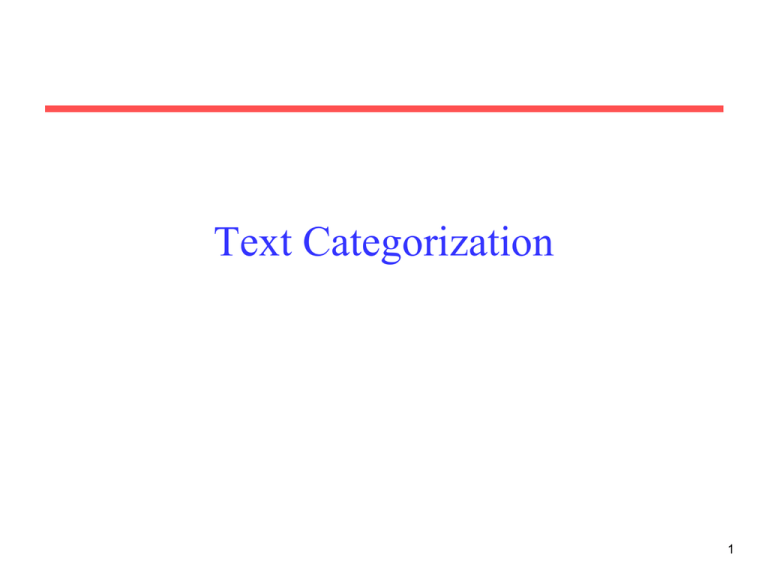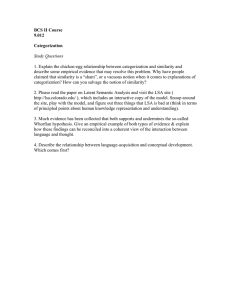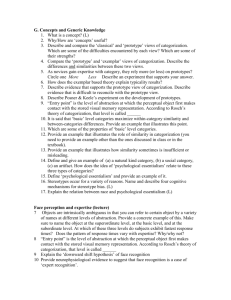Text Categorization 1
advertisement

Text Categorization
1
Text Categorization
• Assigning documents to a fixed set of categories.
• Applications:
– Web pages
• Recommending
• Yahoo-like classification
– Newsgroup Messages
• Recommending
• spam filtering
– News articles
• Personalized newspaper
– Email messages
•
•
•
•
Routing
Prioritizing
Folderizing
spam filtering
2
Learning for Text Categorization
• Manual development of text categorization
functions is difficult.
• Learning Algorithms:
–
–
–
–
–
–
Bayesian (naïve)
Neural network
Relevance Feedback (Rocchio)
Rule based (Ripper)
Nearest Neighbor (case based)
Support Vector Machines (SVM)
3
The Vector-Space Model
• Assume t distinct terms remain after preprocessing;
call them index terms or the vocabulary.
• These “orthogonal” terms form a vector space.
Dimension = t = |vocabulary|
• Each term, i, in a document or query, j, is given a
real-valued weight, wij.
• Both documents and queries are expressed as
t-dimensional vectors:
dj = (w1j, w2j, …, wtj)
4
Graphic Representation
Example:
D1 = 2T1 + 3T2 + 5T3
D2 = 3T1 + 7T2 + T3
Q = 0T1 + 0T2 + 2T3
T3
5
D1 = 2T1+ 3T2 + 5T3
Q = 0T1 + 0T2 + 2T3
2
3
T1
D2 = 3T1 + 7T2 + T3
T2
7
• Is D1 or D2 more similar to Q?
• How to measure the degree of
similarity? Distance? Angle?
Projection?
5
Term Weights: Term Frequency
• More frequent terms in a document are more
important, i.e. more indicative of the topic.
fij = frequency of term i in document j
• May want to normalize term frequency (tf) by
dividing by the frequency of the most common
term in the document:
tfij = fij / maxi{fij}
6
Term Weights: Inverse Document Frequency
• Terms that appear in many different documents
are less indicative of overall topic.
df i = document frequency of term i
= number of documents containing term i
idfi = inverse document frequency of term i,
= log2 (N/ df i)
(N: total number of documents)
• An indication of a term’s discrimination power.
• Log used to dampen the effect relative to tf.
7
TF-IDF Weighting
• A typical combined term importance indicator is
tf-idf weighting:
wij = tfij idfi = tfij log2 (N/ dfi)
• A term occurring frequently in the document but
rarely in the rest of the collection is given high
weight.
• Many other ways of determining term weights
have been proposed.
• Experimentally, tf-idf has been found to work well.
8
Similarity Measure
• A similarity measure is a function that computes
the degree of similarity between two vectors.
• Using a similarity measure between the query and
each document:
– It is possible to rank the retrieved documents in the
order of presumed relevance.
– It is possible to enforce a certain threshold so that the
size of the retrieved set can be controlled.
9
Cosine Similarity Measure
• Cosine similarity measures the cosine of
the angle between two vectors.
• Inner product normalized by the vector
lengths.
dj q ( wij wiq )
CosSim(dj, q) =
dj q
wij wiq
t3
1
D1
t
i 1
t
i 1
2
t
2
2
Q
t1
i 1
t2
D2
D1 = 2T1 + 3T2 + 5T3 CosSim(D1 , Q) = 10 / (4+9+25)(0+0+4) = 0.81
D2 = 3T1 + 7T2 + 1T3 CosSim(D2 , Q) = 2 / (9+49+1)(0+0+4) = 0.13
Q = 0T1 + 0T2 + 2T3
D1 is 6 times better than D2 using cosine similarity but only 5 times better using
inner product.
10
Using Relevance Feedback (Rocchio)
• Relevance feedback methods can be adapted for
text categorization.
• Use standard TF/IDF weighted vectors to
represent text documents (normalized by
maximum term frequency).
• For each category, compute a prototype vector by
summing the vectors of the training documents in
the category.
• Assign test documents to the category with the
closest prototype vector based on cosine
similarity.
11
Illustration of Rocchio Text Categorization
12
Rocchio Text Categorization Algorithm
(Training)
Assume the set of categories is {c1, c2,…cn}
For i from 1 to n let pi = <0, 0,…,0> (init. prototype vectors)
For each training example <x, c(x)> D
Let d be the frequency normalized TF/IDF term vector for doc x
Let i = j: (cj = c(x))
(sum all the document vectors in ci to get pi)
Let pi = pi + d
13
Rocchio Text Categorization Algorithm
(Test)
Given test document x
Let d be the TF/IDF weighted term vector for x
Let m = –2 (init. maximum cosSim)
For i from 1 to n:
(compute similarity to prototype vector)
Let s = cosSim(d, pi)
if s > m
let m = s
let r = ci (update most similar class prototype)
Return class r
14
Rocchio Properties
• Does not guarantee a consistent hypothesis.
• Forms a simple generalization of the
examples in each class (a prototype).
• Prototype vector does not need to be
averaged or otherwise normalized for length
since cosine similarity is insensitive to
vector length.
• Classification is based on similarity to class
prototypes.
15
Nearest-Neighbor Learning Algorithm
• Learning is just storing the representations of the
training examples in D.
• Testing instance x:
– Compute similarity between x and all examples in D.
– Assign x the category of the most similar example in D.
• Does not explicitly compute a generalization or
category prototypes.
• Also called:
– Case-based
– Memory-based
– Lazy learning
16
K Nearest-Neighbor
• Using only the closest example to determine
categorization is subject to errors due to:
– A single atypical example.
– Noise (i.e. error) in the category label of a
single training example.
• More robust alternative is to find the k
most-similar examples and return the
majority category of these k examples.
• Value of k is typically odd to avoid ties, 3
and 5 are most common.
17
Illustration of 3 Nearest Neighbor for Text
18
Rocchio Anomoly
• Prototype models have problems with
polymorphic (disjunctive) categories.
19
3 Nearest Neighbor Comparison
• Nearest Neighbor tends to handle
polymorphic categories better.
20
K Nearest Neighbor for Text
Training:
For each each training example <x, c(x)> D
Compute the corresponding TF-IDF vector, dx, for document x
Test instance y:
Compute TF-IDF vector d for document y
For each <x, c(x)> D
Let sx = cosSim(d, dx)
Sort examples, x, in D by decreasing value of sx
Let N be the first k examples in D. (get most similar neighbors)
Return the majority class of examples in N
21
Naïve Bayes for Text
• Modeled as generating a bag of words for a
document in a given category by repeatedly
sampling with replacement from a
vocabulary V = {w1, w2,…wm} based on the
probabilities P(wj | ci).
• Smooth probability estimates with Laplace
m-estimates assuming a uniform distribution
over all words (p = 1/|V|) and m = |V|
– Equivalent to a virtual sample of seeing each word in
each category exactly once.
22
Naïve Bayes Generative Model for Text
spam
legit
spam spam
legit legit
spam spam
legit
Category
Viagra
win
hot ! !!
Nigeria deal
science
lottery nude
Viagra
!
$
PM
computer Friday
test homework
March score
May exam
spam
legit
23
Naïve Bayes Classification
Win lotttery $ !
??
??
spam
legit
spam spam
legit legit
spam spam
legit
Viagra
win
hot ! !!
Nigeria
deal
Category
science
lottery nude
Viagra
!
$
PM
computer Friday
test homework
March score
May exam
spam
legit
24
Text Naïve Bayes Algorithm
(Train)
Let V be the vocabulary of all words in the documents in D
For each category ci C
Let Di be the subset of documents in D in category ci
P(ci) = |Di| / |D|
Let Ti be the concatenation of all the documents in Di
Let ni be the total number of word occurrences in Ti
For each word wj V
Let nij be the number of occurrences of wj in Ti
Let P(wj | ci) = (nij + 1) / (ni + |V|)
25
Text Naïve Bayes Algorithm
(Test)
Given a test document X
Let n be the number of word occurrences in X
Return the category:
n
argmax P(ci ) P(ai | ci )
ci C
i 1
where ai is the word occurring the ith position in X
26
Sample Learning Curve
(Yahoo Science Data)
27




